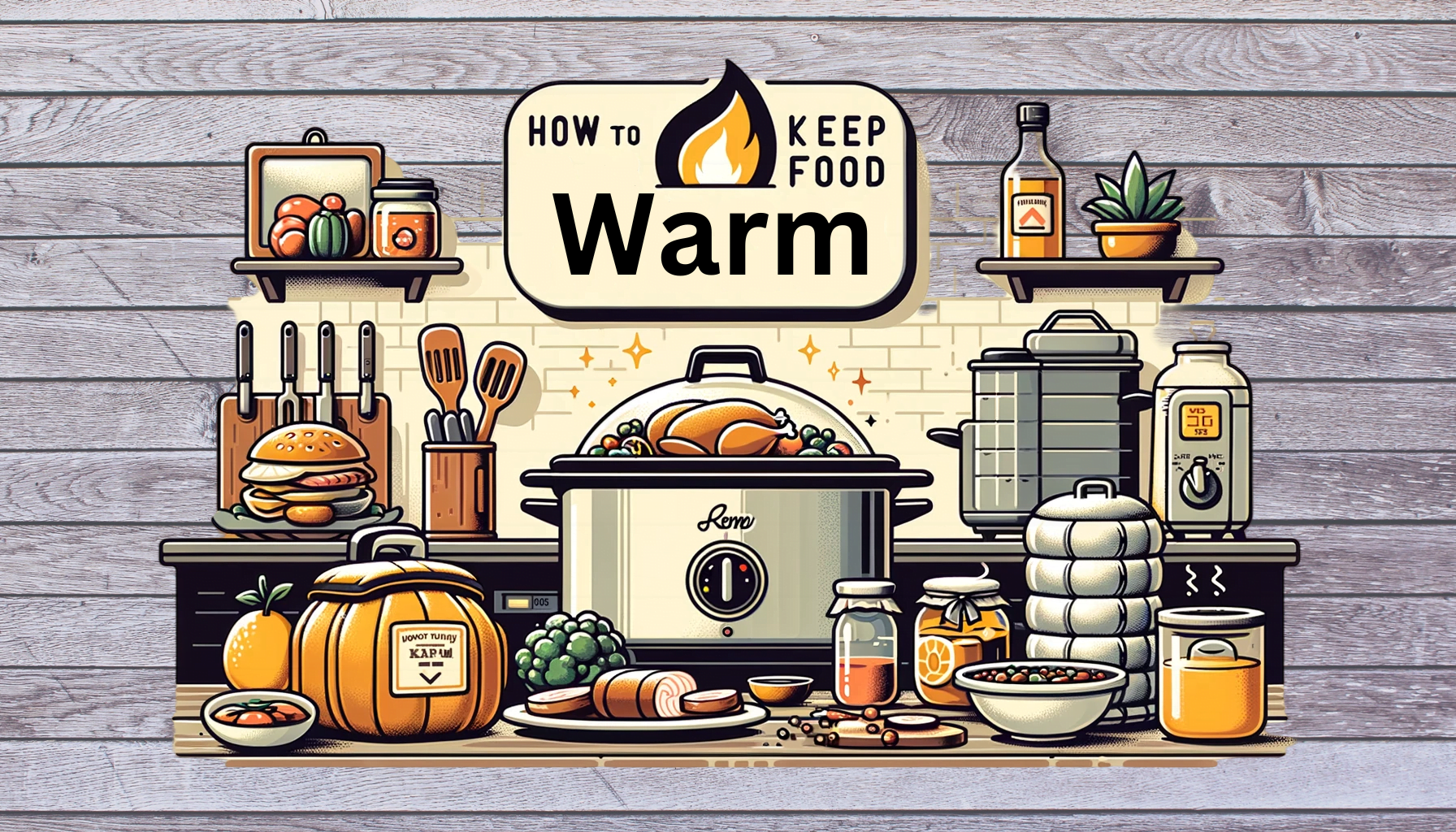Key Takeaways
| Aspect | Details |
|---|---|
| Safe Temperature | USDA Guidelines for keeping grilled meat warm safely above 140°F. |
| Insulation Methods | Use thermal bags, aluminum foil, towels, and coolers |
| DIY Heat Sources | Utilize solar ovens, hay boxes, wonderbags, heated bricks, and hot water bottles |
| Alternative Appliances | Slow cookers, rice cookers, instant pots, toaster ovens, BBQ grills |
| Serving Strategies | Buffet style with chafing dishes, warming trays, thermoses for sauces |
| Specific Food Techniques | Different methods for meats, vegetables, starches; sous vide cooking |
| Food Safety | Monitor temperature to keep food out of the 40°F – 140°F danger zone |
Welcome to HowToKeepFoodWarm.com, the haven for food enthusiasts seeking the most effective and creative ways to keep food warm without an oven. Whether you’re hosting a grand party, going for a picnic, or just ensuring your meal remains hot and delicious, we’ve got you covered.
The Importance of Keeping Food Warm
Keeping food warm is not just about taste; it’s also about safety, particularly when you need to keep food warm without an oven. The golden rule is to maintain food above 140°F, the threshold that keeps it out of the bacterial danger zone. This is especially crucial for large gatherings where food is prone to sitting out for extended periods. Exploring how to keep food warm without an oven is vital in these situations, ensuring that your dishes remain both delicious and safe for everyone to enjoy.
Innovative Insulation Methods
- Insulated Containers: Thermal bags, containers, and wraps are your first line of defense in retaining heat. These are perfect for small-scale needs and short-term solutions.
- Aluminum Foil and Towels: A simple yet effective method. Wrap your dishes in foil and then in towels for added insulation.
- Coolers: Surprisingly, coolers are not just for keeping things cold. Pre-heat them with hot water, and they become a cozy haven for your warm dishes.
Discover more about these techniques in our detailed guides on keeping omelettes warm and keeping pancakes warm.
DIY Heat Sources
For those who love a bit of ingenuity, there are several DIY options:
- Solar Ovens: Ideal for sunny days. Use the power of the sun to keep your food warm.
- Hay Boxes and Wonder bags: These are traditional, eco-friendly methods that use insulation to retain heat.
- Heated Bricks and Hot Water Bottles: A rustic yet effective way to maintain warmth, especially useful for outdoor settings.
Alternative Appliances
When your oven is out of the equation, turn to these trusty appliances:
- Slow Cookers and Crackpots: Ideal for keeping soups, stews, and casseroles warm.
- Rice Cookers and Instant Pots: These aren’t just for cooking; they can also keep food warm effectively.
- Toaster Ovens and BBQ Grills: Perfect for quick reheating and keeping food warm.
Need to keep that grilled food warm? Check out our guide on how to keep grilled food warm.
Serving Strategies for Gatherings
Hosting a party? Here’s how to keep everything warm:
- Buffet Style: Use chafing dishes and warming trays to keep a variety of dishes warm.
- Thermoses for Sauces: Keep your gravies and sauces hot in a thermos, ready to pour over your main dishes.
For more insights, explore our articles on keeping fried food warm for a party and keeping pizzas warm.
Find The Best Food Warming Methods for your Needs
Food-Specific Warming Techniques
Different foods require different warming approaches:
- Meats: Use low-temperature methods like sous vide to keep them juicy and warm.
- Vegetables: Serve them hot off the grill or use a warming tray.
- Starches: Rice and potatoes can be kept warm in a cooker or wrapped in foil.
For more detailed techniques, visit our sections on main dishes and side dishes.
Advanced Food Enthusiast Tips for Keeping Food Warm
Outdoor Warming Solutions
Outdoor events pose unique challenges in keeping food warm. Here’s how to overcome them:
- Grills as Warming Stations: Utilize the residual heat of a gas or charcoal grill to keep food warm. Cover the food in foil and place it on the cooler side of the grill.
- Portable Food Warmers: Devices that plug into car outlets can keep your food warm during travel. Ideal for road trips and picnics.
- Insulated Picnic Baskets: They are designed to maintain temperature, whether it’s keeping salads cool or casseroles warm.
Explore more on how to keep food warm while traveling and keeping food warm at picnics.
Specific Food Focus
Different foods demand specific warming techniques. Here’s a breakdown:
- Pizza and Sandwiches: Keep these in insulated bags or wrapped in foil. Learn more about keeping pizza warm and sandwich warming methods.
- Bacon and Fried Foods: Use a low oven or warming drawer to keep these crispy. Discover techniques in keeping bacon warm and maintaining the crispiness of fried foods.
- Rice and Ravioli: These can be kept warm in a rice cooker or a crock pot. Check out our guides on keeping rice warm and keeping ravioli warm.
Desserts and Baked Goods
Don’t forget the sweet treats! Keeping desserts warm can be as simple as using a low-heat oven or a covered dish. For more tips, visit our desserts section.
Making Your Own Hot Packs
DIY enthusiasts can create hot packs to keep food warm. This involves materials like fabric bags filled with grains or gel packs that can be microwaved. Our guide on how to make a hot pack to keep food warm provides step-by-step instructions.
Incorporating Technology
Today’s food warmers come with advanced features like temperature control and even smartphone connectivity. These modern appliances offer precise temperature maintenance for food safety and taste. Explore our fast-food section for the latest in food warming technology.
Final Thoughts
At HowToKeepFoodWarm.com, we understand the nuances and importance of serving food at just the right temperature. Whether you’re a seasoned chef or a casual cook, our comprehensive guides, tips, and product recommendations are designed to ensure that your dishes are enjoyed the way they were meant to be – warm and delicious.
Remember, the art of keeping food warm is as important as the cooking itself. It’s about preserving the essence, flavor, and safety of your food. We’re here to help you do just that, with confidence and ease.
People Also Ask Section
Q1: What are some effective ways on How to keep food warm without oven?
A: You can utilize insulated thermal bags, food warmers, or thermal containers. Wrapping food in aluminum foil and towels is also effective. Using a pre-warmed cooler or employing heat sources like hot water bottles or heated bricks can help retain the heat.
Q2: Can a cooler be used to keep food warm?
A: Yes, coolers can effectively keep food warm. To do this, first warm the cooler with hot water, then empty and dry it. Place food wrapped in aluminum foil inside the cooler. The insulation designed to keep cold out also works to retain heat.
Q3: Are there any DIY methods to maintain food temperature?
A: There are several DIY methods to keep food warm. These include wrapping food in aluminum foil and towels for insulation, using a cooler lined with hot towels, creating a solar oven for use on sunny days, or employing a hay box or wonder bag for slow, insulated warming.
Q4: What is the safest temperature to keep food warm?
A: Above 140°F (60°C) to prevent bacterial growth
Q5: How do you keep food warm for a party?
A: To keep food warm for a party, consider using chafing dishes, warming trays, or slow cookers. Serving buffet-style with covered dishes helps, as does using insulated containers. For temporary warming, a BBQ grill set to a low setting can also be effective.
Q5: Can I use a rice cooker to keep food warm?
A: Absolutely! A rice cooker can double as a warmer for foods like rice, vegetables, and even small cuts of meat.



